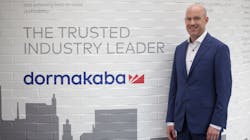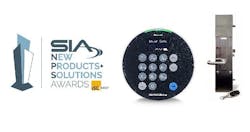Assuming the business operations reins of a global company in good times is an inherently stressful situation for any C-level executive, but doing so amid a worldwide health pandemic presents challenges that surely never were covered at The Krannert School of Management at Purdue University. Yet this is where Alex Housten found himself on April 1, no less, as he prepared to lead one of the world’s largest access control and security solutions provider’s operations in the United States, Canada, Mexico and South America. Housten is the newly appointed chief operating officer for Access Solutions AMER at dormakaba.
Stepping into the breach with the business world running in crisis mode might intimidate a lesser executive. Housten, however, is confident that his business acumen, training and the core values he inherited at dormakaba are enough to maintain stability in times of chaos. Housten’s progression up the leadership ladder before joining dormakaba has prepared him to put equal weight on developing a strong corporate culture and an innovative technology road map. Taking lessons learned from his time with Carrier Corp.’s Fire & Security Products Americas business, Housten vows to translate his experience in the industry into realistic business goals during the crisis.
“I'm sure I'm going to draw on things from all parts of my career here, but first and foremost, dormakaba is a company that has some really strong core values and a long track record of operating by those values in a variety of market conditions,” says Housten as he settled into his new Indianapolis headquarters office. “A circumstance like COVID-19 is really no exception, so we expect those values to guide us as we make decisions. As a company, we have a long-term strategy with a long-term value-creation mindset. We make a medium-term operating plan so that we have a way of getting there. And then, as leadership in the company, we have an obligation to react and adapt to conditions in real-time, and COVID-19 is one of those cases.”
Make the Plan, Work the Plan
Housten already has seen this action plan initiated as it pertains to mitigating risk and ensuring the safety of all the organization’s employees and staff at every level of the production process. He points out that the entire dormakaba team has been faithful about conducting essential business operations within full cooperation of Centers for Disease Control and Prevention guidelines for social distancing. He adds that each factory has had to do a tremendous amount of reconfiguration from the way its production lines work to the assembly cell areas, with all of this redesign being done while production continued.
“We have to run our business reflecting the current demands in the marketplace,” Housten says. “There are certain segments right now that have been more impacted than others, and there are certain projects that are under more pressure than others. In all cases, we worked with our channels and with our customers to accommodate the kind of reasonable business terms that have been required so that we continue to be seen as a partner at the end of this thing. And there will be an end.”
The ongoing pressures squeezing business and day-to-day operations are something Housten understands. His mentor-like leadership style has been typified by a pair of values he sees as being even more essential now in this time of crisis — communication and transparency.
“It’s very important in a time like this to be available to share the message of what it is our company is doing to endure and get through this crisis while retaining our strength. We must let everyone know what it is that we have to do that looks different than it once did,” Housten says, adding that a good example of that has been how his team reconfigured all of its work to a mostly remote working environment. “Our business looks totally different than it did just one month ago. But communicating the changes and sharing that change we’re all experiencing helps ease the stress.”
The transparency part of the operations equation has been noticeably more difficult for Housten and the entire executive staff. The nature of the “new normal” of social distancing and hunkering down at home negates the necessary interaction that drives sales, marketing and research and development at global organizations. That fact isn’t lost on Housten.
“Being visible is a little bit more difficult given the separation of staff,” Housten explains. “I had been very, very selective in travel in the last weeks, and that was not the plan for this period of time. I was looking forward to shaking as many hands of my new colleagues as I could. But we found a way, with a webcast and some audio messages that we’ll make available in a podcast, to help with our transparency. We’re going to be a lot more regular about just simple things, like recording a short video on our mobile phones here and distributing it to the workforce so that we can be in front of folks with messaging and also remain visible. I think that gives everybody the ability to understand what the company is doing, that we’re active in leading through this phase of our history, and that we have not sacrificed any of our plans for the future or values in the way we operate.”
And when that future normality returns, it’s even more important that the role of any company continues to hinge on its partnerships with customers and its channel. As Housten sees it, a solutions provider is only as good as its last transaction with a client. Developing a lasting trust doesn’t stop at the last sale.
“I have an expectation that everybody involved in the business here is aware of our obligation to do well inside our walls to support customers but also be mindful of how we present ourselves as active partners outside of our walls,” Housten stresses. “It is only then that we can see challenges that customers and users face and develop business models and products that support those needs as they change and evolve in our modern society. That’s not related to a particular technology road map. I’m not telling you about a product we’re going to develop. This is all about a culture of being aware that we are not in business just to be a company; we’re in business because we're a piece of something bigger.”
Technology Still Plays
As the fallout from the novel coronavirus pandemic begins to reshape corporate cultures and public norms, technology also must adapt. Global disruptions, such as COVID-19, are transformational, and, according to Housten, the effect on future technologies will be just as dramatic as the new social mores.
“These kinds of big global events always change industries, and access-control security is no exception,” Housten says. “I think back to the world before Sept. 11, 2001. Security protocols for airports and big office buildings in cities were one thing. Now they are totally different. Circumstances changed how you present yourself in an airport terminal and how you engage with an airline and businesses in the airport. Restrictions on liquids and things that, at the time, might have been seen as temporary measures. I would expect that we are going to face a similar new normal. What will it be? I don’t have something specific other than I think there are some obvious likely trends that are sure to emerge.”
He surmises that there will be more frictionless or touchless entry points in exterior and interior facilities and that secured entrances, such as automatic doors, will be more prevalent in public spaces. He also figures that access control might move more to mobile credentials and away from cards and tokens.
“The desire not to have so many high-touch, common-touch surfaces in public and company spaces that we go to each and every day is going to be a consistent trend that you will see develop,” he says.
Housten doesn’t put much stock into the notion that access control technology trails other flashier tech sectors, saying he believes that technology and innovation remain a great opportunity for access control companies such as dormakaba.
“Part of our long-term strategy at dormakaba is to have more interoperable, connected products — products that provide more than their first purpose for installation,” he asserts. “In most cases, that’s data-driven solutions. It is critical for us to take data back to some aggregating system that allows building owners to do all the things they want to do with a building, whether it is security, safety, compliance, convenience or just improving operating efficiency for the end user. I believe dormakaba is extremely well-positioned to drive and meet expectations of end users and in the channel for technological advancement in this regard. The reality is we are going to have more and more connected solutions, connected products. We have a robust digital road map and our products definitely have a purpose and a reason why you install them.”






